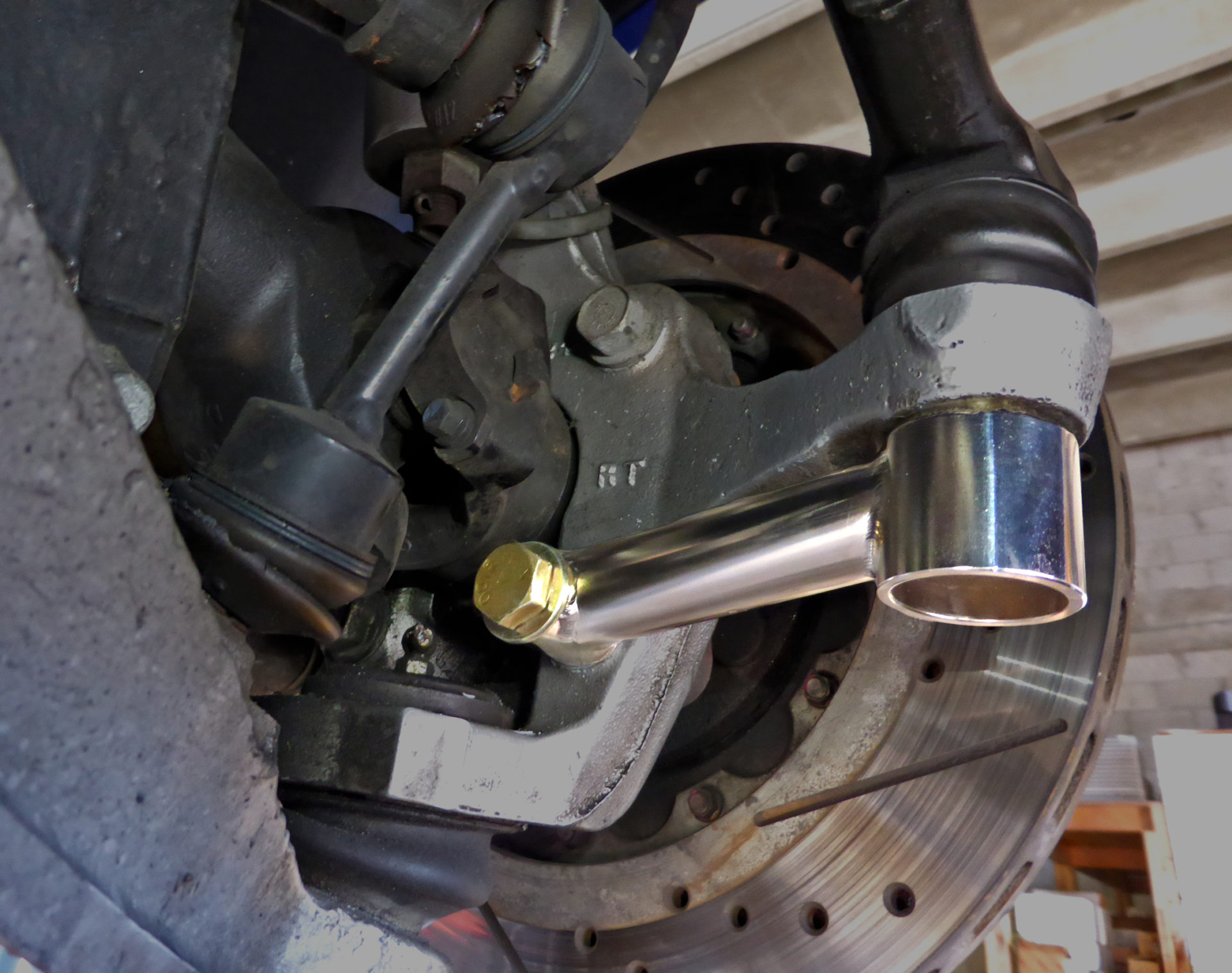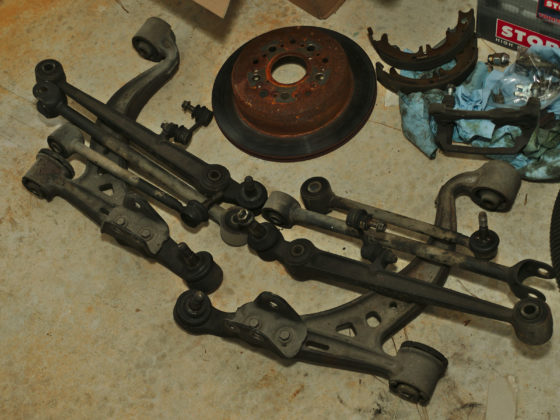FRONT TOE STIFFENER:
Erik also makes Toe Stiffeners for the front upright (knuckle). After completely isolating the front steering system (rack, inner and outer ends, etc…) Erik was able to measure approximately the same amount of deflection as the rear knuckle/hub: ¼” per side. This front deflection is not as concerning as the rear since the front suspension does not see the same kind of load that the rear does.
Since the front end is constantly moving to steer the car, the main benefit of the front stiffeners is improved steering accuracy and driver feel. While this improvement is still very important, it is not as extreme as the unwanted and unpredictable movements in the rear end of the car. In all honesty, for a street driven car, on street rubber, without aerodynamic aids, I don’t believe it is a needed modification like the rear Stiffener. Now a racing car using slicks, solid mounted rack, aero, and looking for those last consistent tenths of a second, it would definitely be worth it. Or if you have the money and want to improve every aspect of the car, then by all means the car will most likely drive better with them installed on a street car.
CONCLUSION
We were blown away by how much of a difference the EMI Racing Toe Stiffeners made. Reducing rear toe deflection from 1/2″ to less than 1/32” is substantial for handling, performance, and driveability. To me, the Stiffeners are worth it just for the peace of mind alone, since an upright (knuckle) failure due to an off track spin in the dirt would cost more than the Stiffener itself. The Toe Stiffeners completely transform the car on track, making the handling much more precise and refined. To us they are a must-have for every Gen 2 Viper owner.
Stay tuned for the next installment of Project Viper GTS.
SOURCES:
EMI Racing





23 comments
Great article! Any chance you could place a link up top as to where to get the stiffeners? They sound necessary and I’d love to buy them for my GTS as well. Thanks!
Wow; kind of concerning that the stock uprights were that marginal. The brace seems to take care of things but I guess it highlights stuff that didn’t get caught in the design stage.
… I swear, every time I see a new update in this series come up I start checking ebay.
You brought it to a shop for a 2 bolt nothing comes off bolt on????
Should we all start bribing Dave Coleman and Eric Hsu to write again?
Miatabusa………………
That is a pretty lame statement. Would you rather have no photography and no article?
He doesn’t wrench, but he can wheel better than any of the aforementioned names. Can relay what effects the setup changes made better than most and that is more signal and less noise.
Billy can wrench and he is pretty damn good. I have seen him do it. Why do some of you feel that you have to pick this article apart in such a dumb sniveling way? Wouldn’t you rather have the car on a lift with good photography rather than some weird angles and lighting on jack stands?
I would rather take better photos of the install on a lift and give credit to a friend and owner of a great shop than to show how cool I am for working out of my home garage with jackstands and a small, 10 gallon air compressor tank.
Exactly!
I’m with Brad. Where can I get a set of these? Thanks!
Hey Billy, I know exactly what you are feeling from damper testing I did with a certain company as a consultant a few years back. I was able to get rid of most of it through spring rate and damper tuning but some was still there. Now I know what was the issue. If we had these, I bet I could have backed off on some stuff and gotten more mechanical grip. I was really impressed by how well the Viper did on the track. Pounding really hard in the Arizona summer heat and no heat, tire or brake issues. When we were done, the car was a sweetheart to drive too. Tamed the bobbing and twichyness and went a few seconds a lap faster to boot. We tested and developed settings with Pirelli and Michelin slicks as well as the OEM tires.
That brace would work better made from square tubing.
I would say no since quite a bit of the load is torsional. Square section tubing is stiffer in straight bending though. It is also about 20% heavier for equivalent strength.
Just curious how does one measure/find out on the toe deflection. I can understand what a driver feels when it deflects but how did you measure to amount that was deflected?
I’m always fascinated by this. Keep up the great work/articles guys.
What I have done in the past is to make a simple fixture for a magnetic based dial indicator.
I’m assuming you’re measuring this after a session or doing a tear down to see if if the part/knuckle has deformed.
I can’t imagine you’re using that with a camera pointed at the whole dial jig whilst it’s on track. Haha
I believe Erik had the chassis on a kinematics rig and loaded the suspension to measure the deflection and/or had strain gauges & potentiometers on a car to measure the deflection.
This deflection is due to a lack of stiffness. This deflection is also (thankfully) lower than the yield point of the arm, at which it has been known to snap and not just deform.
I was not aware that aluminum could bend so much, so often, without breaking more easily than it does.
I’ve seen one or two similar products for Miatas (ND in particular), the front knuckle of which weighs like 2.x pounds. I’ve never heard of any breaking, but… has anyone else?
Where can one purchase the stiffeners??
Can someone please advise where these can be purchased? I am eager to install these and track test it.
How do I purchase a set for the rear on a 1997 GTS?
Great write up and wow… I knew the rear toe was an issue but never considered the upright. Makes perfect sense and I’m sold on Eriks solution. Attempting to contact him now, if only to save my uprights before I get more wild in my 99 GTS.
how does one get the EMI Toe Stiffener.
That is a very good question…